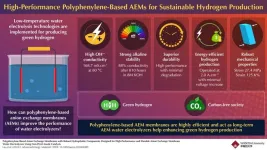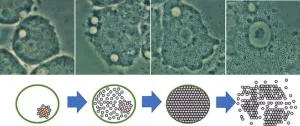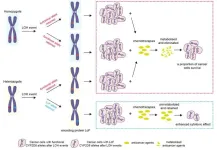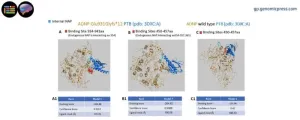Hydrogen is a promising energy source due to its high energy density and zero carbon emissions, making it a key element in the shift toward carbon neutrality. Traditional hydrogen production methods, like coal gasification and steam methane reforming, release carbon dioxide, undermining environmental goals. Electrochemical water splitting, which yields only hydrogen and oxygen, presents a cleaner alternative. While proton exchange membrane (PEM) and alkaline water electrolyzers (AWEs) are available, they face limitations in either cost or efficiency. PEM electrolyzers, for instance, rely on costly platinum group metals (PGMs) as catalysts, whereas AWEs often operate at lower current densities and efficiencies.
Anion exchange membrane water electrolyzers (AEMWEs) combine benefits of both PEM and AWEs, using low-cost, non-PGM catalysts while supporting higher current densities and energy conversion efficiencies. However, AEMs face technical challenges, especially degradation under alkaline conditions, which impacts long-term stability. Advances in AEM materials, particularly those enhancing chemical durability, conductivity, and mechanical strength, are critical to overcoming these challenges.
To address these issues, Professor Kenji Miyatake from Waseda University, Japan working alongside researchers at the University of Yamanashi, developed a new anion exchange membrane (AEM) with durable hydrophobic components. They published their study in the journal Advanced Energy Materials on 29 September 2024. High hydroxide ion (OH ̅) conductivity, which is essential for excellent performance in AEM water electrolyzers (AEMWEs), is another feature of this membrane, which is made to withstand extreme alkaline conditions. Miyatake stated, "The polymer-based membrane used in this study satisfies the fundamental requirement for robust, effective materials in the production of green hydrogen to be used in water electrolysis."
The incorporation of 3,3''-dichloro-2',5'-bis(trifluoromethyl)-1,1':4',1''-terphenyl (TFP) monomers into the polyphenylene backbone of the membrane is a crucial aspect of this breakthrough. Since its composition enhances stability, it possesses the capacity to endure more than 810 hours of exposure to high concentrations of potassium hydroxide at 80 °C which shows its durability in industrial applications.
The membrane demonstrated consistent performance during water electrolyzer testing, sustaining a constant current density of 1.0 A.cm-² for over 1,000 hours with minimal voltage change. According to Miyatake, "The durability shown here is an encouraging sign that our membrane can help reduce costs in hydrogen production."
Further, the membrane’s OH ̅ conductivity reached 168.7 mS.cm-1 at 80 °C, surpassing the values mentioned in earlier research studies. This high conductivity is critical for achieving high current densities needed to make hydrogen production efficient. By combining durability with such high conductivity, the team believes this material design marks an important advance toward scalable and affordable hydrogen production.
With a tensile strength of 27.4 MPa and an elongation capacity of 125.6%, the membranes offer strong resilience, beneficial for stable performance over time. The durability and efficiency of these AEMs make them a valuable component in sustainable hydrogen production, supporting carbon-neutral energy initiatives. These results hold promise for applications involving green hydrogen.
The study successfully demonstrates that polyphenylene-based AEMs with hydrophobic components significantly enhance stability and exhibit high hydroxide ion conductivity with superior alkaline stability, minimizing degradation even in challenging environments. The membrane enables stable performance over prolonged operation at high current densities, marking it as an efficient, cost-effective option for green hydrogen production in AEM water electrolyzers.
This research has brought us one step closer to a future of sustainable energy.
***
Reference
DOI: https://doi.org/10.1002/aenm.202404089
Authors: Fanghua Liu1, Kenji Miyatake1,2,3, Ahmed Mohamed Ahmed Mahmoud1, Vikrant Yadav1, Fang Xian1, Lin Guo1, Chun Yik Wong1, Toshio Iwataki2, Yuto Shirase2, Katsuyoshi Kakinuma2, and Makoto Uchida2
Affiliations
1Clean Energy Research Center, University of Yamanashi, Japan
2Hydrogen and Fuel Cell Nanomaterials Center, University of Yamanashi, Japan
3Department of Applied Chemistry, Waseda University, Japan
About Waseda University
Located in the heart of Tokyo, Waseda University is a leading private research university that has long been dedicated to academic excellence, innovative research, and civic engagement at both the local and global levels since 1882. The University has produced many changemakers in its history, including nine prime ministers and many leaders in business, science and technology, literature, sports, and film. Waseda has strong collaborations with overseas research institutions and is committed to advancing cutting-edge research and developing leaders who can contribute to the resolution of complex, global social issues. The University has set a target of achieving a zero-carbon campus by 2032, in line with the Sustainable Development Goals (SDGs) adopted by the United Nations in 2015.
To learn more about Waseda University, visit https://www.waseda.jp/top/en
About Professor Kenji Miyatake from Waseda University, Japan
Dr. Kenji Miyatake is a leading scientist at Waseda University and the University of Yamanashi in Japan, where he specializes in materials science and ion-conductive polymers for energy applications. His work focuses on innovative membrane design to advance fuel cell and hydrogen production technologies, which are key in the global shift towards carbon-free energy. He also works on all-solid-state air batteries using ion-conductive polymers and redox active organic molecules.
END







